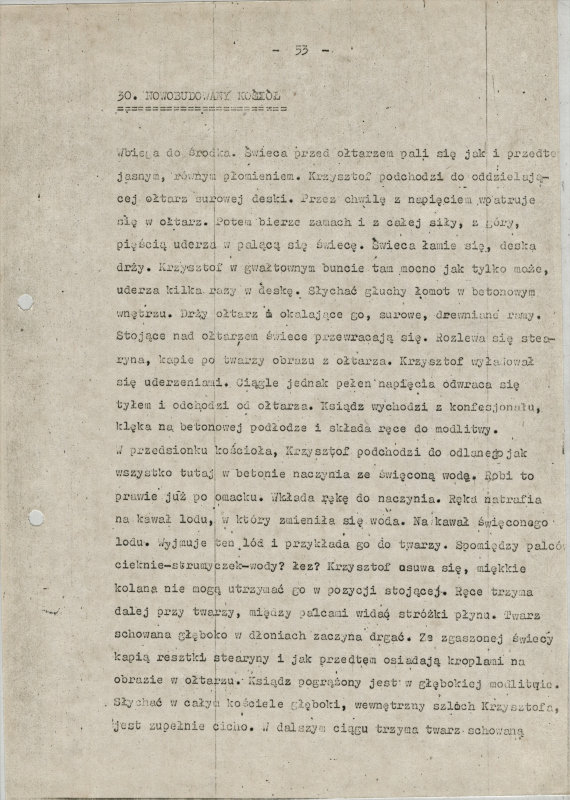Church of the Ascension in Ursynów
The Church of the Ascension is one of the most recognizable landmarks in Ursynów, commonly known as Warsaw’s “bedroom neighborhood.” The original plans for the surrounding neighborhood, which were drawn up during the People’s Republic of Poland, did not call for any places of worship. However, in the latter half of the 1970s church authorities decided to establish a parish in this location. The unfinished church was opened to the faithful in May 1989.
Decalogue One
Krzysztof, the lead character in the film, played by Henry Baranowski, enters an empty candle-lit church on the darkest evening of his life. His only son has just drowned, no more than a few dozen meters from where he now stood. Expressing his deep-seated refusal to accept the tragedy that has just befallen him, the man topples the makeshift altar set up in the newly built church. The wax from a fallen candle drips onto the visage of Our Lady of Częstochowa, flowing down her cheeks like tears. The copy of the venerated icon from the Jasna Góra Monastery reminds us that the tragic events take place in Poland, where the Black Madonna plays an important historical role. In an early draft of the screenplay, Krzysztof’s violent outburst of grief and defiance happens in front of a priest whom he meets in the church. In the end, the character of the vicar is omitted entirely from the film. He was also cut from the final scene of another episode, Decalogue Eight, in which he initially appeared as the son of the main character, Zofia, who shares with him the good news: the Jewish girl believed to have died in the war has turned up alive.
Mikołaj Jazdon
“Hidden signs” (2)
In the previous scene at the lake, the father did not fall to his knees, unlike the onlookers gathered around the hole in the ice under which his son had died. He never recognized the sovereignty of any God. He believed in reason. He suffers all the more. He has no one to turn to, because his reason places the blame on him. Nearby, a new church is being built to serve the housing complex. But especially now, in such dark times, the Father cannot recognize its “Christian values,” the ones he heard about from his equally helpless sister. The church is still under construction, a makeshift parish, as if it were not quite ready to serve its purpose. But this apparent powerlessness is perhaps what speaks to the grief-stricken father, what testifies to him. The Father walks into the church, possibly out of spite, and proceeds to search, half blindly… He sees the black slashes on the cheek of Our Lady of Częstochowa—the only visible part of the Madonna’s entire face, shrouded in darkness. The cuts immediately bring to mind the cracks in the ice that swallowed the Boy. The Father lifts a thin sheet of ice from the holy water font, its glassy texture—like the lens of the Enlightenment raised to the eye of faith—bringing the entire tragedy into focus. Hitherto omnipotent, reason is helpless in the face of his son’s death and the mathematical error that effectively caused the accident. We witness something suddenly come to life in the Father and spur him into action: not defiance, which is pointless in the face of “nothingness,” but rather despair. An answer then appears: the wax tears “wept” by the image of the Madonna links the Father’s grief and the slash of the sword; this plexus of meanings that stands in for natural defiance echoes the atmosphere of the hymn Stabat Mater, secretly leading us up to Golgotha. Was this deliberately written into the screenplay? No answer is necessary. The film speaks for itself, and therein lies its greatness.
